Pediatric Surgery: Intestinal Malrotation
Intestinal Malrotation
Basics
- Definition: Failure of the Normal Embryonic Gut Rotation
- Position of Pylorus & Splenic Flexure Generally Constant
- Associated Syndromes:
- Congenital Diaphragmatic Hernia
- Congenital Heart Disease
- Gastroschisis
- Omphalocele
Embryonic Gastrointestinal Rotation
- Normal Rotation: 270 Degree Counterclockwise Around the SMA
- Both Duodenojejunal & Cecocolic Loops Rotate 270 Degrees Counterclockwise
- Stages:
- Stage 1: Bowel Herniation into Umbilical Cord & Initial Rotation
- Week 6: Bowel Extends into the Umbilical Cord (Small Bowel, Right Colon & Proximal Transverse Colon)
- Week 10: Bowel Returns into the Abdomen
- Stage 2: Completion of Bowel Rotation
- Stage 3: Mesentery Fixation
- Stage 1: Bowel Herniation into Umbilical Cord & Initial Rotation
- Ladd’s Bands – Fibrous Attachment from the Cecum to the Right Retroperitoneum
- In Malrotation They Can Cross Over the Second/Third Portion of Duodenum
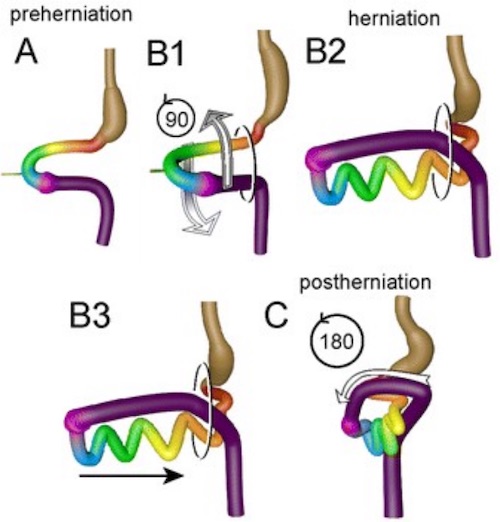
Classic “En-Bloc Rotation” Model of Gut Morphogenesis: Midgut Herniates and Rotates 90-Degrees (B1), Forms Loops (B2), & Slides Back into the Abdomen (B3). The Midgut Then Rotates an Additional 180-Degrees to its Final Position (C). 1
Presentation
- Symptoms:
- Bilious Vomiting
- Abdominal Pain
- Abdominal Distention
- Malabsorption
- Failure to Thrive
- Complications:
- Midgut Volvulus
- Small Bowel Twists Around a Pedicle Causing Vascular Compromise
- High Risk Due to Narrowed Mesenteric Pedicle
- Excessively Long Mesentery or Adhesion Points Can Create an Axis to Twist Around
- One-Third Present Before Age 1 Month
- Duodenal Obstruction
- From Ladd’s Bands Crossing Over the Duodenum & Causing Extrinsic Compression
- Most Common Cause of Duodenal Obstruction in Peds > 1 Week & Overall
- Mesocolic Internal Hernia
- Potential Spaces Develop Due to Lack of Mesenteric Fixation of Right/Left Colon
- Midgut Volvulus
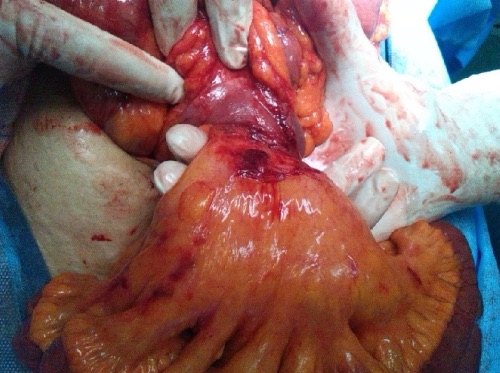
Malrotation Causing Volvulus 2
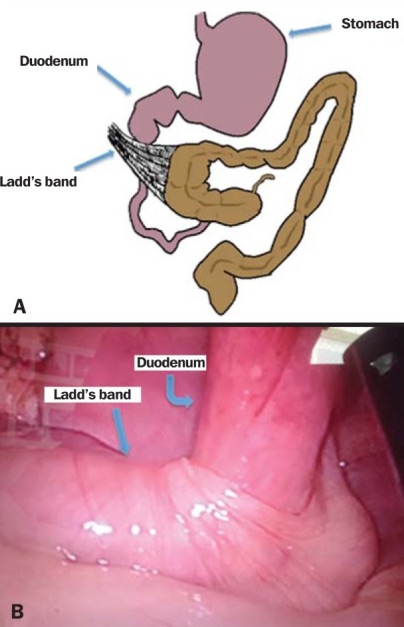
Malrotation Causing Duodenal Obstruction 3
Diagnosis
- Dx: Upper GI (Only if Stable)
- Duodenum Does Not Cross Midline & is Displaced to the Right
- US Findings: SMV Left/Anterior of SMA
- Volvulus Findings:
- “Bird’s Beak” Narrowing
- Mesenteric “Whirl”
- Double-Bubble
- If Unstable: Proceed Immediately to OR
Treatment
- Treatment: Ladd Procedure
- Most Surgeons Recommend Surgical Correction Even if Asymptomatic
- If Found Incidentally in Adults, Most Surgeons Still Recommend Surgical Correction Although it Remains Controversial
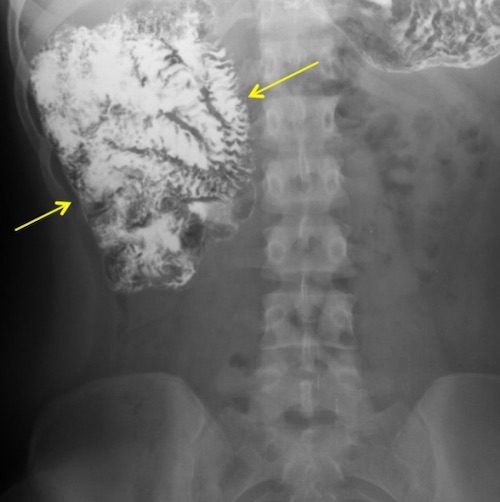
Malrotation on UGI 4
Ladd Procedure
Procedure
- Eviscerate Bowel
- Counterclockwise Rotation/Reduction of Bowel
- Lysis of Ladd’s Bands
- Relieves Constriction
- Appendectomy
- Avoid Diagnostic Errors Later in Life Due to Abnormal Positioning
- Place Cecum into the Left Lower Quadrant
- Broadens the Mesentery Base to Prevent Recurrence
- *Do Not Fixate the Duodenum or Colon – Increases Risk for Recurrent Obstruction
Final Anatomic Placement
- Duodenum in Right Upper Quadrant
- Small Bowel on Right
- Cecum in Left Lower Quadrant
- Colon on Left
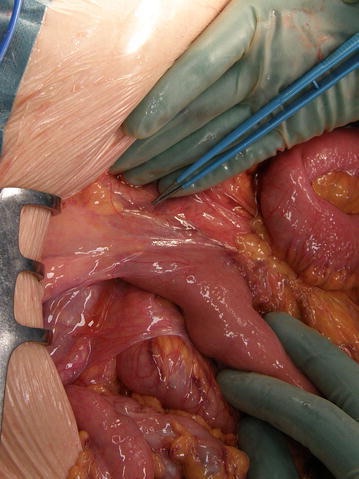
Ladds Bands 5
References
- Soffers JH, Hikspoors JP, Mekonen HK, Koehler SE, Lamers WH. The growth pattern of the human intestine and its mesentery. BMC Dev Biol. 2015 Aug 22;15:31. (License: CC BY-4.0)
- Shahverdi E, Morshedi M, Allahverdi Khani M, Baradaran Jamili M, Shafizadeh Barmi F. Utility of the CT Scan in Diagnosing Midgut Volvulus in Patients with Chronic Abdominal Pain. Case Rep Surg. 2017;2017:1079192.(License: CC BY-4.0)
- Sala MA, Ligabô AN, de Arruda MC, Indiani JM, Nacif MS. Intestinal malrotation associated with duodenal obstruction secondary to Ladd’s bands. Radiol Bras. 2016 Jul-Aug;49(4):271-272. (License: CC BY-4.0)
- Santacana-Laffitte G, Ruiz L, Pedrogo Y, Colon E. Cystic adnexal mass in a 16-year-old female: Ovarian pathology or complication of a Müllerian anomaly? Am J Case Rep. 2013 May 15;14:153-156. (License: CC BY-NC-ND-3.0)
- Husberg B, Salehi K, Peters T, Gunnarsson U, Michanek M, Nordenskjöld A, Strigård K. Congenital intestinal malrotation in adolescent and adult patients: a 12-year clinical and radiological survey. Springerplus. 2016 Mar 1;5:245. (License: CC BY-4.0)